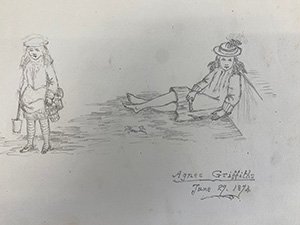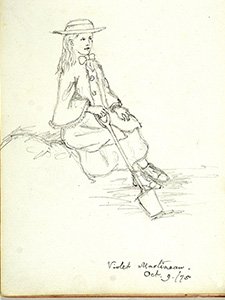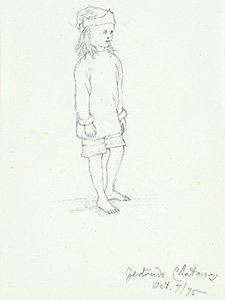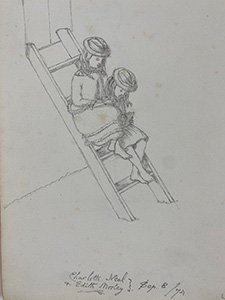 These are not brilliantly accomplished sketches, but they nevertheless capture the simple pleasures of days beside the sea. They are to be found in a slim sketchbook taken on holidays during the early 1870s by Charles Lutwidge Dodgson, otherwise Lewis Carroll (reference DFC/A/22/1). 'Alice in Wonderland' (1865) and 'Alice Through the Looking Glass' (1871) had already brought Dodgson success as children's writer Lewis Carroll. The sketches are mementoes of golden hours spent with a few of his 'child friends' whose conversation and observations helped to motivate Carroll's work.
These are not brilliantly accomplished sketches, but they nevertheless capture the simple pleasures of days beside the sea. They are to be found in a slim sketchbook taken on holidays during the early 1870s by Charles Lutwidge Dodgson, otherwise Lewis Carroll (reference DFC/A/22/1). 'Alice in Wonderland' (1865) and 'Alice Through the Looking Glass' (1871) had already brought Dodgson success as children's writer Lewis Carroll. The sketches are mementoes of golden hours spent with a few of his 'child friends' whose conversation and observations helped to motivate Carroll's work.
 On the first holiday, of June 1874, two drawings of Agnes Griffiths read as a small sequence of events. Agnes from the left of the page is encumbered: bucket and spade, with her stiff skirts tucked above bloomers, striped stockings and neat shoes below. Later (and larger) Agnes, occupying most of the page, reclines carelessly bare legged, perhaps after happy times among the rock pools (a liberated crab sidles away).
On the first holiday, of June 1874, two drawings of Agnes Griffiths read as a small sequence of events. Agnes from the left of the page is encumbered: bucket and spade, with her stiff skirts tucked above bloomers, striped stockings and neat shoes below. Later (and larger) Agnes, occupying most of the page, reclines carelessly bare legged, perhaps after happy times among the rock pools (a liberated crab sidles away).
In September of the same year, Charlotte Neal and Edith Morley are charmingly captured as they perch companionably reading on the steps down to the sand, sunning their feet.
The following year, 1875, a later holiday to the Isle of Wight took place in early October. Two sketches in the book and also a poem commemorate this occasion. There is a sketch of Violet Martineau with her spade, dressed in the customary stiff, booted attire of the Victorian girl. Gertrude Chataway, however, looks different:
'Girt with a boyish garb for boyish task,
Eager she wields her spade',
 begins the acrostic poem (spelling her name vertically with the first letter of each line). The bare legged girl in the picture, although contemplative rather than spade-wielding, wears shorts, a fisherman's jersey and cap. The poem appears as the dedication of Carroll's seafaring epic nonsense poem 'The Hunting of the Snark' (1876), and acknowledges Gertrude's part in his inspiration to complete the work. Carroll's earliest idea for the poem had come to him during a summer's walk in Guildford in July 1874. Perhaps the carefree Gertrude's influence is to be seen in the Snark's liking for bathing machines, but the poem is curiously dark to coincide with Carroll's 'bright' memories.
begins the acrostic poem (spelling her name vertically with the first letter of each line). The bare legged girl in the picture, although contemplative rather than spade-wielding, wears shorts, a fisherman's jersey and cap. The poem appears as the dedication of Carroll's seafaring epic nonsense poem 'The Hunting of the Snark' (1876), and acknowledges Gertrude's part in his inspiration to complete the work. Carroll's earliest idea for the poem had come to him during a summer's walk in Guildford in July 1874. Perhaps the carefree Gertrude's influence is to be seen in the Snark's liking for bathing machines, but the poem is curiously dark to coincide with Carroll's 'bright' memories.
Of the Snark, Carroll commented with a typical humour, 'people have…tried to find the meanings in it. The one I like best (which I think is partly my own) is that it may be taken as an allegory for the pursuit of happiness'.
 The sketchbook was set aside probably not long after the October holiday. Most subsequent pages have been left blank. Since Carroll continued to enjoy drawing for the rest of his life, perhaps it was just left behind at the Dodgson family's Guildford home and forgotten, only to be realised as a treasure years later after his death. It is now part of the Dodgson Family Collection at Surrey History Centre, and features this July in celebration of 150 years since 'The Hunting of the Snark' was begun.
The sketchbook was set aside probably not long after the October holiday. Most subsequent pages have been left blank. Since Carroll continued to enjoy drawing for the rest of his life, perhaps it was just left behind at the Dodgson family's Guildford home and forgotten, only to be realised as a treasure years later after his death. It is now part of the Dodgson Family Collection at Surrey History Centre, and features this July in celebration of 150 years since 'The Hunting of the Snark' was begun.
Sources
Carroll's letter concerning the Snark is quoted in 'The Annotated Snark, Lewis Carroll', edited by Martin Gardner (1962).
Images
- Sketch of Agnes Griffiths, 1874 (reference DFC/A/22/1 page 3)
- Sketch of Violet Martineau, 1874 (reference DFC/A/22/1/7)
- Sketch of Gertrude Chataway, 1875 (reference DFC/A/22/1 page 6)
- Sketch of Charlotte Neal and Edith Morley, 1874 (reference DFC/A/22/1 page 5)

